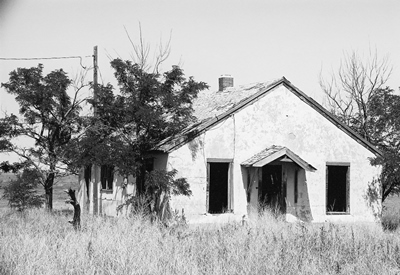
The first thing that strikes one about Pep, at least before visiting, is its name. It might seem a little unusual, except that there’s another town called Pep 60 miles dead east in Texas. In fact, it’s been said that Pep, New Mexico got its name directly from Pep, Texas. It’s also been said that Pep was named for a fortified breakfast cereal popular during the Depression. Neither of those stories is true though and, really, Pep was probably named for the reason you’d guess at first glance.
The place that would become Pep was settled in the fall of 1925 by Edward Cox, who established the first residence and store. T.M. Pearce, who wrote New Mexico Place Names, concluded that Pep got its name because Cox expected it to be a “lively and energetic place.” Apparently Pep was a word used often during the Depression to instill enthusiasm. That’s how Texas got its Pep, too.
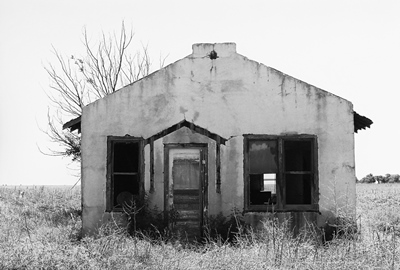
I’ve been told that there was a big party to get the town going, including a baseball game and rodeo. The post office opened in 1936--possibly beating Pep, TX to the name--and remains in operation to this day, despite the fact that there are only a handful of residents left. The post office also serves the ranches and farms of the surrounding area, of course, but is now only open in the morning and mail is not delivered every day.
Pep is in Roosevelt County, on the western edge of the legendary rangeland known as the Llano Estacado, or “Staked Plain.” I described the 30,000 sq. mi. Llano Estacado a bit in the last post when we explored nearby Causey. There’s a lot of folklore surrounding why this formidable mesa is known as the Staked Plain. The term is perhaps better translated as “Palisaded Plain,” the “palisaded” likely referring to the high, rocky escarpments that border the tableland, particularly to the east,
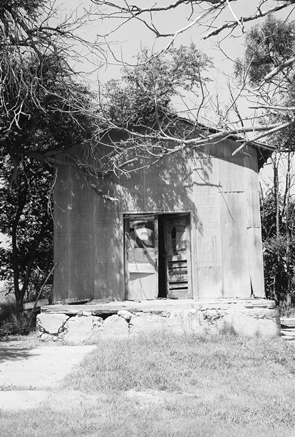 where one, the Caprock Escarpment, reaches 300 feet tall. A common but probably less accurate explanation is that the “stakes” are really the dried shoots of yuccas, which can rise a few feet above ground and thus appear as scattered stakes as you look out over the landscape. My favorite is that early settlers “staked” their trails with buffalo bones and skulls so that they could follow them back out if they got lost, like macabre bread crumbs. Recently the Hillsboro Historical Society told me that Robert Julyan believes “estacado” may be incorrect and that the original Spanish word could’ve been “estancada” or, “ponded.” Indeed, after a rainfall water collects in the small depressions across the plains and thus “Ponded Plain” might be fitting. Which is right? I’d do like everyone else does and just go with whatever you like best!
where one, the Caprock Escarpment, reaches 300 feet tall. A common but probably less accurate explanation is that the “stakes” are really the dried shoots of yuccas, which can rise a few feet above ground and thus appear as scattered stakes as you look out over the landscape. My favorite is that early settlers “staked” their trails with buffalo bones and skulls so that they could follow them back out if they got lost, like macabre bread crumbs. Recently the Hillsboro Historical Society told me that Robert Julyan believes “estacado” may be incorrect and that the original Spanish word could’ve been “estancada” or, “ponded.” Indeed, after a rainfall water collects in the small depressions across the plains and thus “Ponded Plain” might be fitting. Which is right? I’d do like everyone else does and just go with whatever you like best!As for personages, science fiction author Jack Williamson was from Pep. Known as the “Dean of Science Fiction,” he published in every decade from the 1920’s to the 2000’s. He also built a little wooden cabin near his parent’s house so that he could write undistracted. I don’t know exactly where it is and I’ve heard it’s decaying…but still standing! I’d sure like to get a photo of it.
So why did Pep not live up to its name? Initially Cox, who owned all the land in town, may have tried to sell it at too high a price during a bad economic time for the country. Maybe it was the name in the first place; Pep, Texas has wound up in a similar state. But the record on Pep is spare, to say the least.
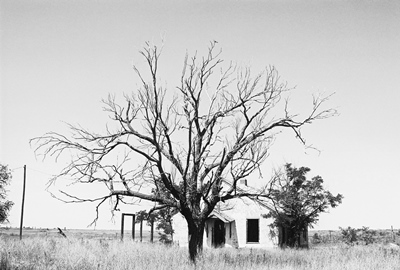
While it’s difficult to uncover the history of the little town, let alone the stories of the people that lived there, that does not make Pep unimportant. In fact, I would argue, quite the opposite. A couple months ago I posted a photo from Pep on the City of Dust Facebook page. After it had been shared around a bit, I found a comment which says more in a few words than I probably have in this whole piece. I don’t know the commenter, but I’d be happy if they somehow stumbled across this post so that I could give them my thanks for such a beautiful sentiment. Hopefully they wouldn’t mind that I’ve used their quote to end this latest installment!
“This post may be the only place in the entire world where the old community of Pep is being discussed. Pause for a moment, if you will, to honor those who gave their all here -- gambling on a new life -- in the Great American Desert.” G. L.
Information for this post came from almost nowhere. Robert Julyan provided the lion’s share in a single paragraph in The Place Names of New Mexico. I cobbled together some of the text on the Llano (or, yar-nah, if you like) from V.H. Whitlock’s book, Cowboy Life on the Llano Estacado. Various other bits were taken from personal correspondence and whatever else I could dig up. I learned a little bit about Pep, TX, the town from where F. Stanley published all those yellow “New Mexico Story” pamphlets, from THIS PAGE. Thanks again to G.L.
Now we’ll go a little bit west and somewhat more north to the also memorably-named town of House.
OCTOBER 2015 UPDATE: As of late September 2015, the entire town of Pep is up for sale. For somewhere around $300,000 you will get 318 acres, a (habitable) residence, a post office, and a community center, as well as everything shown in this post. Interested? Contact Wayne Baker at Master Realty in Portales, NM (575-356-6607). I was tempted to make an offer but my financial planner told me my portfolio is looking a little too thin right now.
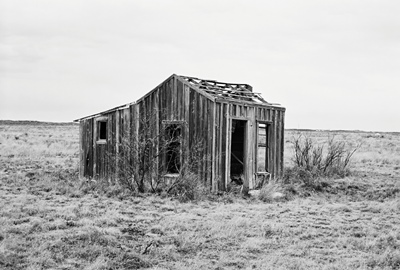
MARCH 2016 UPDATE: Well, I finally made it back to Pep to see Jack Williamson's writing shack, which he built with his own hands in the 1930's. There's even a small tub--more of a shallow metal box, really--inside so that he could bathe and continue writing with minimal interruption. I thank the Williamson family for graciously inviting me out to their ranch and also providing a wonderful lunch! I'm very grateful to have been able to photograph this important piece of New Mexico literary history.
16 comments:
I am Jack Williamson's niece and know exactly where this shack is. I tried to email you, but my computer and your email don't work together. Can you put your email address on here?
Thank you so much for your e-mail, Betty Williamson! I would love to know where the shack is. You can e-mail me at:
jmhouse(at)cityofdust(dot)com
I look forward to hearing from you!
Thanks again! JM
I was hoping the origin of the name of Pep would be more conclusive or as interesting as the name of another town on the Staked Plains, Jal. Jack Williamson wrote some great stories. His body of work lies within the core of great writers of SF, I’m sorry I never got to meet him. I’d sure like for you to post an image of his little writing shack.
The secret of Jal’s name: https://en.wikipedia.org/wiki/Jal,_New_Mexico
The JAL (John A. Lynch) brand is featured in Cowboy Life on the Llano Estacado, along with an entire chapter describing all the other brands in the region at the time. Definitely conclusive as far as the name of the subsequent town!
House's origin story is pretty conclusive, too, as you'll see next time. The origin of the name of Field, not far from House, is unknown, but if you drive through it...seems fairly obvious.
I'd love to get a photo of Jack Williamson's shack. I shall see what I can do! JM
I m Jack Williamson's nephew. I received my mail and listed Pep as my permanent address for many years starting in about 1961.
In elementary school, both in Texas and New Mexico I was taught that the Llano Estacado was named by Coronado as he searched for the 7 Cities of Cibola. The high plains were so flat he had to plant stakes to navigate. But that is from history books written for use in the late 1950s.
- Larry Littlefield
Thanks for your comment, Larry! Believe it or not, your story of how the Llano Estacado got its name is not one I'd come across. Coronado was certainly the earliest European through the region, so...maybe?! I love Coronado's quote:
"I reached some plains so vast, that I did not find their limit anywhere I went, although I traveled over them for more than 300 leagues...with no more land marks than if we had been swallowed up by the sea...there was not a stone, nor bit of rising ground, nor a tree, nor a shrub, nor anything to go by."
Llano Estacado is a great name regardless. So evocative yet non-specific, which is probably why there are so many tales about its origin.
Incidentally, with the help of your relatives, I hope to pay a visit to your uncle's writing cabin very soon! Are you related to the Littlefield's of LFD Ranch fame, too?!
Thanks again! JM
My family homesteaded west of Pep in the late 1800s - early 1900s (my Grandparents ranch was est in 1906) & my parents are there today. My Grandpa, sadly has passed, but the stories he had of taking a horse drawn-wagon into Portales for supplies... driving the old Dora school bus... etc.
If you need info in the area I'd be happy to hook you up - my Dad knows most of the old stories, where the old homesteads are, and so forth.
Thank you for your comment, Raymona Toombs-Powell! That sounds like a fascinating family history. Very little of Pep's past was written down and, of course, the oral tradition can be difficult to document. In many cases, the stories are fading quickly.
Your grandfather didn't happen to drive the bus around Causey, too, did he? There's a story about a tornado in May 1930 which struck while the students from Causey were on a field trip. The "buses" were a Chevy truck and a Whippet. Everyone took shelter in a chicken house and one student got a bloody nose from an egg-sized hailstone.
Anyway, I'd love to hear more stories about Pep! You can contact me directly via e-mail at: jmhouse(at)cityofdust(dot)com.
Thanks again for your message! JM
Ramona, I thought the world of your grand parents. Your grand dad was a good rancher, local tax preparer, and the community handy man. I'm Robin's dad. derrellsmith@sbcglobal.net
My dad was the last person to run the country store that is now called the community center. His name was Gray Alan Wilson. He ran the store for about 25 years and was also the oldest person to be hired as the postmaster. He ran the post office for about 15 years. He and my mom lived in the house next door. he continued to run the store after my mom died. At 92 he still operated the store he fell and broke his hip. He passedaway in 2006 and we sold it about 3 years later. Melinda Coslett
No, at least not very closely related to the LFD Ranch, or Colonel George Littlefield. Two very distant cousins at best. My father came to the Williamson place as a young farm hand from the Brownfield, Tx area and married the boss's daughter, Jack's sister.
I think I recall your parents' former house, Melinda Coslett. The metal shop (feed store, perhaps?) is in between, right? Of course, the whole town is up for sale right now, including the post office and community center. I believe about $300,000 will get you the Pep zip code.
Larry Littlefield, I made a return trip to Pep in December and visited the Williamson's ranch. Some photos of Jack's writing shack, which he built in the 1930's, will appear on the City of Dust FACEBOOK PAGE very soon!
Thanks, guys! JM
I am really not sure how my family ended up with a Fantastic picture of Jack Williamson’s cowboy boots dated May 25, 1941 iif any family member or friend is interested I would love to share the picture. I’ve had it next to my bed for years and was just looking at it.
Thanks for your message, Susan Hewett Lucas! That is really something that you have a photo of Jack Williamson's cowboy boots from almost 80 years ago. I'm certainly interested in seeing the picture and I bet Jack's family would be, too. I'll get in touch with them.
What's the best way to contact you? I can be sent an e-mail through the address associated with my profile at the top right of this page.
Thanks again! JM
Having lived in Hobbs as a kid, I remember this area when my parents drove up to Clovis for whatever led them there. I remember Pep and my sister and I created a little song about it, although I cannot recall exactly how it went. Glad to have found this blog post.
I imagine it's been years since anyone has posted a comment here, but: I made sure I passed through Pep (both of them, actually) while returning to California from a Thanksgiving trip to Dallas. I stopped and took in the community center, the post office, the house for sale by Enchanted Lands real estate (a Berkshire Hathaway company), and snapped a few pictures. I happened across your post while I was looking for information about Pep's history, and I'm grateful for how lovingly you've recounted the story of the place and for the connections you made in the comments. Well done.
Post a Comment